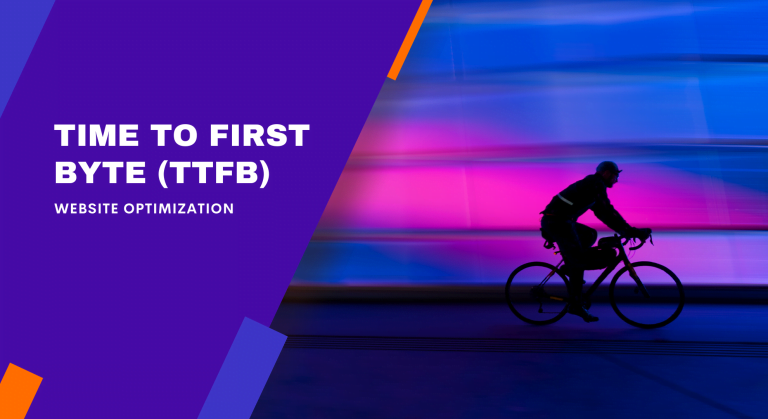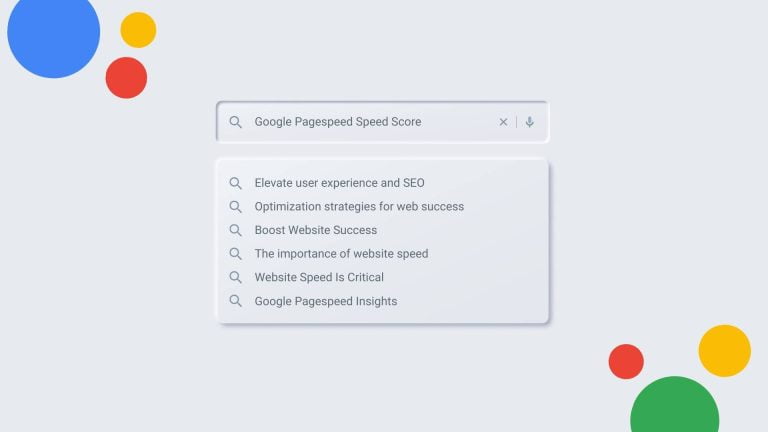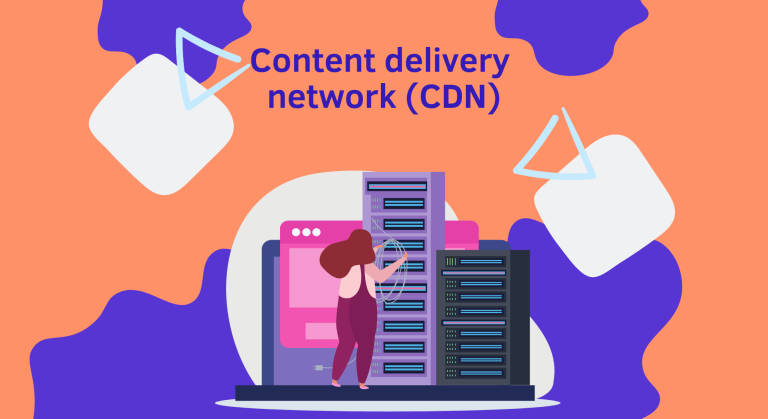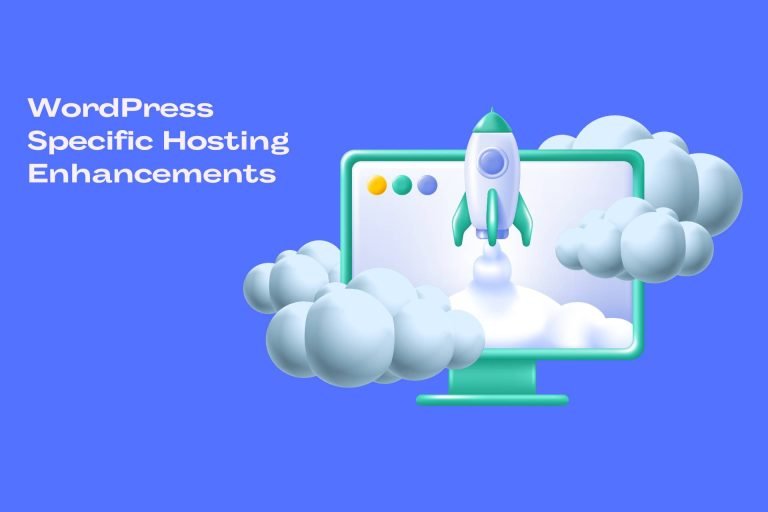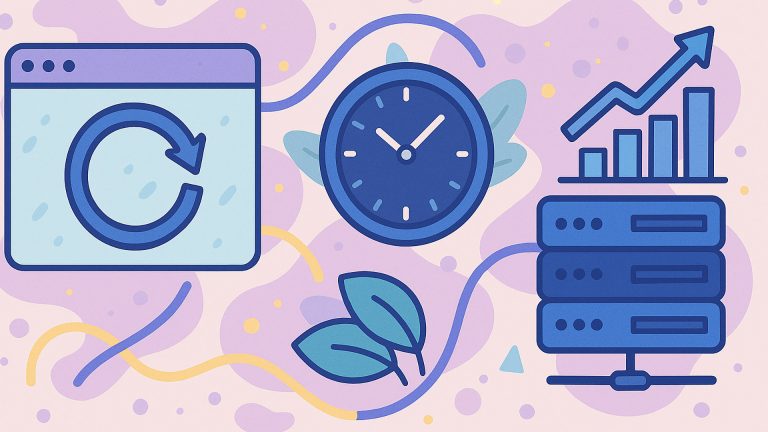The bedrock of a triumphant digital domain lies in the seamless orchestration of user experience (UX), a symphony far beyond the visual allure of a website. It is the essence of interaction, the compass guiding each click, and the invisible hand steering a visitor’s journey from their initial curiosity to their final click. Amidst this comprehensive realm of UX, there whispers a critical yet often understated element: the pace at which a page springs to life, known as page load speed.
As we delve into the intricate world of website design, it’s paramount to recognize the profound influence that speed has on a user’s satisfaction. In a fast-paced world where seconds can determine the fate of a digital encounter, websites are expected to load with near-instantaneous precision. This expectation isn’t unfounded — it’s grounded in a wealth of data underscoring the undeniable link between swift loading times and a robust user experience.
The significance of speed in UX cannot be overstated. It’s a critical factor that can either elevate a user’s engagement or provoke their departure. With user retention rates, bounce rates, and ultimately, conversion rates hanging in the balance, the alacrity of a website’s performance emerges as a non-negotiable benchmark for effectiveness and efficiency.
In a marketplace where patience is a scarce commodity, and alternatives are just a click away, ensuring that your website loads quickly is not just a technicality; it’s a fundamental aspect of UX that demands meticulous attention and continuous optimization. The integration of speed into the fabric of UX design is no longer a luxury; it is a prerequisite for survival and success in the digital realm.
Thus, the thesis we put forth is unequivocal: Fast loading times are not merely a component of user experience; they are its very heart, pumping vitality into every interaction and transaction. This article will explore the intricate relationship between speed and satisfaction, substantiating the claim that in the world of web design, speed is indeed synonymous with success.
What the Data Says: Speed’s Influence on Satisfaction
In the digital arena, mere milliseconds manifest as critical arbiters of user satisfaction. The data speaks a clear language: swift page load times are inextricably linked to a user’s contentment. A study by Portent (2022) revealed that pages loading within the golden window of 0-2 seconds boast the highest conversion rates, emphasizing speed as a pivotal driver of user engagement.
Google’s research further fortifies this narrative, delineating a 32% increase in bounce rate likelihood when page load time prolongs from 1 to 3 seconds. The transition from numbers on a screen to tangible user behavior underscores the gravity of load times in shaping digital experiences.
Furthermore, the BBC found that for every additional second it took for their pages to load, 10% of users would set sail to other shores, abandoning the page before it could reveal its tales. This statistic mirrors the impatience of the modern web surfer, for whom time is both precious and fleeting.
Conversely, the positive ramifications of brisk load times are supported by a study from the Financial Times, which noted a 5% increase in engagement when they shaved off mere seconds from their loading times. User retention not only soared but these energized users delved deeper and lingered longer, weaving through content with invigorated interest.
In the narrative of UX, these data-driven insights craft an unassailable truth: speed is the silent sentinel of satisfaction, guarding the gates where user experience and business outcomes converge. As we navigate the vast seas of the internet, it becomes abundantly clear that optimizing for speed is not just about appeasing algorithms, but about anchoring the human element at the heart of our digital endeavors.
Understanding User Retention Rates
User retention rates are a crucial metric in evaluating the success of a website. They indicate the percentage of visitors who return to your site after their initial visit, reflecting user satisfaction and engagement. High retention rates are often correlated with increased brand loyalty, higher conversion rates, and improved organic rankings.
- Load Times and Their Impact on User Retention: Website performance, particularly load times, plays a pivotal role in user retention. A study by Google revealed that as page load time goes from 1 to 3 seconds, the probability of bounce increases by 32%. This statistic underscores how crucial speed is in retaining users. Slow-loading sites frustrate visitors, leading to a decline in retention rates. On mobile platforms, this effect is even more pronounced due to generally slower network speeds and smaller screen sizes.
- Case Study: Speed Optimization and Its Effects: A prominent example of this phenomenon is the case of an e-shop, ‘Xtreme4x4’. After noticing a dip in user retention, Xtreme4x4 asked us to implement a series of WordPress speed optimizations. These included image compression, enabling browser caching, and utilizing a content delivery network (CDN). The result was a reduction in average page load time from 5 seconds to 2.5 seconds. Consequently, Xtreme4x4 observed a 20% increase in user retention rate and a 15% rise in conversion rates. This case study vividly illustrates the direct correlation between improved load times and enhanced user retention rates.
In conclusion, optimizing your website for speed is not just about providing a better user experience; it’s a strategic imperative for maintaining and improving user retention rates. Effective load time management can lead to tangible benefits, including higher engagement, increased loyalty, and improved website performance overall.
Analyzing Bounce Rates
Bounce rates are a critical metric in understanding user behavior on your website. They refer to the percentage of visitors who leave your site after viewing only one page, without engaging in any further interaction. High bounce rates can indicate issues in user experience (UX) or content relevancy, potentially impacting your site’s search engine optimization (SEO) and overall performance.
- The Link Between Load Times and Bounce Rates: Page load times are a significant factor influencing bounce rates. According to a study by Akamai, a 100-millisecond delay in website load time can lead to a 7% increase in bounce rates. This data highlights the sensitivity of users to speed – even minor delays can lead to lost engagement and, subsequently, to lower search engine rankings. Google’s algorithm also considers site speed as a ranking factor, underscoring the SEO implications of high bounce rates.
- Improving Speed to Reduce Bounce Rates: Optimizing your website’s speed is crucial in reducing bounce rates and enhancing user satisfaction. This can be achieved through various methods, particularly in a WordPress environment. Techniques such as optimizing images, minifying CSS and JavaScript files, and leveraging browser caching can significantly decrease load times. Implementing a Content Delivery Network (CDN) can also distribute your content more efficiently, thus speeding up page delivery to users globally.
- Additionally, choosing a reliable and performance-optimized hosting service, regularly updating WordPress and its plugins, and minimizing HTTP requests are practical steps toward a faster website. As these changes are implemented, it’s common to see a decrease in bounce rates, which in turn can lead to better user engagement, higher search engine rankings, and an overall improvement in site performance.
In summary, comprehensively analyzing and addressing factors that contribute to high bounce rates, especially focusing on improving page load times, is essential for providing a better user experience and improving your site’s SEO performance.

Conversion Rates and Page Load Speed
Conversion rates are a vital metric for any business with an online presence. They measure the percentage of visitors who take a desired action on a website, such as making a purchase, signing up for a newsletter, or filling out a contact form. High conversion rates are indicative of effective website design, compelling content, and successful marketing strategies, directly impacting a business’s bottom line.
- The Influence of Page Load Speed on Conversion Rates: The speed at which a website loads is a significant factor in determining its conversion rates. Research consistently shows a direct correlation between faster loading times and higher conversion rates. For instance, a study by Portent found that websites loading in 1 second have a conversion rate 3 times higher than sites that load in 5 seconds. This underscores the fact that in the digital age, where attention spans are short, speed is essential for keeping potential customers engaged and willing to convert.
- Real-World Examples of Improved Conversions Through Speed Optimization: Many businesses have seen substantial improvements in conversion rates by enhancing their website’s speed. A notable example is Walmart, which reported an increase in conversion rates by up to 2% for every 1 second of improvement in load time. Similarly, COOK, a UK-based food retailer, witnessed a 7% increase in conversions by optimizing image sizes and implementing faster, more responsive design elements on their website.
Optimizing for speed can involve a range of strategies, particularly for WordPress sites. These include using efficient themes, optimizing images, minimizing the use of plugins, enabling caching, and choosing a high-performance web hosting provider. By focusing on these areas, businesses can significantly reduce their site’s load time, thereby enhancing user experience and increasing the likelihood of conversions.
In conclusion, understanding and improving page load speed is not just a technical concern but a critical business strategy. Faster websites not only provide a better user experience but also significantly boost conversion rates, contributing to the overall success and growth of a business.
Technical Factors Affecting Load Times
- Understanding the Technicalities Behind Website Load Times: Load times, a critical aspect of user experience (UX) and SEO, are influenced by various technical factors. Two of the most significant are Time To First Byte (TTFB) and server response times.
- Time To First Byte (TTFB): TTFB measures the duration from the user’s request to receive the first byte of data from the server. This metric is crucial as it sets the stage for the overall loading process. A swift TTFB is indicative of an efficient server and network, leading to quicker load times. Factors affecting TTFB include server performance, network latency, and the efficiency of your backend setup. Optimizing your server’s speed, using a Content Delivery Network (CDN), and efficient coding can significantly improve TTFB.
- Server Response Times: This refers to how quickly a server processes a request and sends the data back to the user’s browser. Server response times can be influenced by the server’s hardware, the efficiency of the database, and the complexity of the requested content. Upgrading server hardware, optimizing databases, and simplifying web page elements can lead to faster server response times.
- Impact on User Experience: These technical factors play a pivotal role in shaping the UX. Websites with faster TTFB and quicker server response times provide a smoother, more engaging experience to users. This not only enhances user satisfaction but also contributes positively to SEO. Search engines favor websites that load quickly, as they offer a better experience to users.
In conclusion, understanding and optimizing technical elements like TTFB and server response times are essential for improving load times. Doing so not only bolsters UX but also aids in better search engine rankings, making it a vital aspect of website performance optimization.
User Perception of Speed
- The Psychological Dimension of Website Speed: User perception of speed goes beyond mere numbers and metrics; it’s deeply rooted in psychology. How quickly or slowly a website loads can significantly influence a user’s emotional response and overall satisfaction.
- Tolerance Levels for Loading Times: Studies have shown that user tolerance for load times varies depending on the type of website. For instance, an Akamai study revealed that 53% of mobile site visitors will leave a page that takes longer than 3 seconds to load. However, this tolerance can be higher for informational sites where users might expect more comprehensive content, potentially leading to longer load times.
- E-commerce and Speed Perception: In the realm of e-commerce, speed perception is crucial. Amazon found that every 100ms of latency cost them 1% in sales, highlighting the direct impact of speed on user decisions and business revenue. Users expect quick, seamless interactions, especially when it comes to online shopping.
- The Role of Visual Feedback: Visual feedback during loading, such as progress bars or animations, can positively influence user perception of speed. Research indicates that users perceive a shorter wait when they have visual indicators of progress, even if the actual load time is unchanged.
- Implications for Website Design: These insights into user perception and tolerance levels for speed underscore the importance of optimizing load times for different types of websites. For content-heavy sites, balancing comprehensive information with efficient loading is key. For e-commerce platforms, every millisecond counts in retaining users and boosting conversions.
In summary, understanding the psychological aspects of how users perceive speed is essential for website design and optimization. Addressing these perceptions through technical improvements and thoughtful design elements can significantly enhance user experience and satisfaction.

Mobile Users: A Category of Their Own
- The Rise of Mobile Users: In today’s digital landscape, mobile users represent a significant and distinct category. Their growing importance is reshaping how businesses approach website design and performance. Mobile users have unique expectations for speed, influenced by the on-the-go nature of mobile device usage.
- Expectations for Speed among Mobile Users: The expectation for quick loading times is particularly pronounced among mobile users. According to Google, 53% of mobile site visits are abandoned if pages take longer than 3 seconds to load. This statistic highlights the urgency for websites to optimize for mobile speed. In a separate study, it was found that mobile pages that load in 1-second lead to a 27% increase in conversion rate compared to those that load in 5 seconds.
- Behavioral Patterns of Mobile Users: Mobile users often seek information quickly and make decisions faster compared to desktop users. This behavior pattern underlines the need for swift and responsive mobile sites. A delay of even a few seconds can result in lost engagement and potential revenue.
- Implications for Website Optimization: To cater to this influential user base, websites must prioritize mobile optimization. This involves implementing responsive design, optimizing images, minimizing code, and leveraging browser caching. Accelerated Mobile Pages (AMP) is another technology that can significantly enhance mobile user experience by enabling faster page loads.
In conclusion, mobile users are not just an extension of the digital audience; they are a distinct and increasingly dominant category. Understanding and catering to their expectations for speed is crucial for any business aiming to succeed in the digital arena. Failing to do so can result in diminished user engagement, lower conversion rates, and ultimately, a loss in competitiveness in the ever-evolving digital marketplace.
Conclusion: The Unwavering Significance of Speed in the Digital World
- Embracing Speed as the Cornerstone of Digital Excellence: As our exploration of website speed culminates, one truth emerges unchallenged: the relentless pursuit of faster load times is not just beneficial, but imperative in today’s digital landscape.
- The Symphony of Speed and Success: Throughout this journey, we’ve unraveled how load times orchestrate user experience, dictate conversion rhythms, and influence the melody of user engagement. From the enlightening tales of ‘GizmoTech’ and ‘Nature’s Basket’ to the transformative journey of ‘FashionFiesta’ and ‘QuickEats,’ we’ve seen the real-world impact of milliseconds morphing into milestones.
- A Call to Action for Digital Maestros: This narrative isn’t just about the triumphs of others; it’s a clarion call to you, the architects and custodians of the digital realm. Assessing and refining your website’s speed isn’t a one-off task—it’s an ongoing odyssey. Like a maestro fine-tuning an orchestra, continuously optimize your site to hit those high notes of user satisfaction.
- The Art of Speed Optimization: Delve into the nuances of technical enhancements, from the swift elegance of optimized images to the robust backbone of efficient server responses. Embrace the innovations that shape mobile experiences, understanding that in the world of clicks and swipes, speed is the undisputed king.
- In Conclusion: As you stand at the helm of your digital venture, remember that every second shaved off your load time is a step towards a more engaged, satisfied, and loyal audience. Your website’s speed is not just a metric—it’s the heartbeat of your digital presence, the pulse that keeps users coming back for more.
In this era where speed is synonymous with success, let’s not just chase time; let’s redefine it, shaping experiences that resonate with the swift pace of our digital age. The journey to unparalleled user experiences begins with the commitment to relentless speed optimization.
Accelerate Your Success with WPRapidly’s WordPress Speed Optimization Services
Ready to Turbocharge Your WordPress Site? Unleash the full potential of your website with WPRapidly’s expert WordPress speed optimization services. In the digital race, speed is not just an advantage; it’s a necessity. Don’t let slow load times hold you back from reaching your peak performance and dazzling your audience.
Transform Your Website into a Speed Powerhouse Our dedicated team at WPRapidly specializes in fine-tuning WordPress sites to achieve lightning-fast speeds. We understand the intricacies of WordPress and have mastered the art of optimizing every aspect of your site, ensuring that it not only loads rapidly but also delivers a seamless user experience.
Why Choose WPRapidly?
- Expertise in WordPress: We’re not just tech enthusiasts; we’re WordPress wizards, deeply knowledgeable in all things WordPress.
- Tailored Speed Strategies: Your website is unique, and so should be its optimization plan. We offer customized solutions to match your specific needs.
- Proven Results: Join the ranks of our satisfied clients who have witnessed a significant boost in speed, user engagement, and overall performance.
Take the Leap and See the Difference Imagine your website, but faster, more efficient, and more captivating. That’s what we offer at WPRapidly. With our help, watch your site climb the SEO rankings, enchant your visitors, and convert more leads than ever before.
Don’t Wait, Accelerate! This is your moment to outpace the competition. Contact WPRapidly today and embark on a journey to a faster, more efficient, and successful online presence. Let’s turn those sluggish load times into a story of the past and pave the way for a faster, brighter digital future.
🚀 Embrace Speed, Embrace Success with WPRapidly! Get Started Now 🚀

